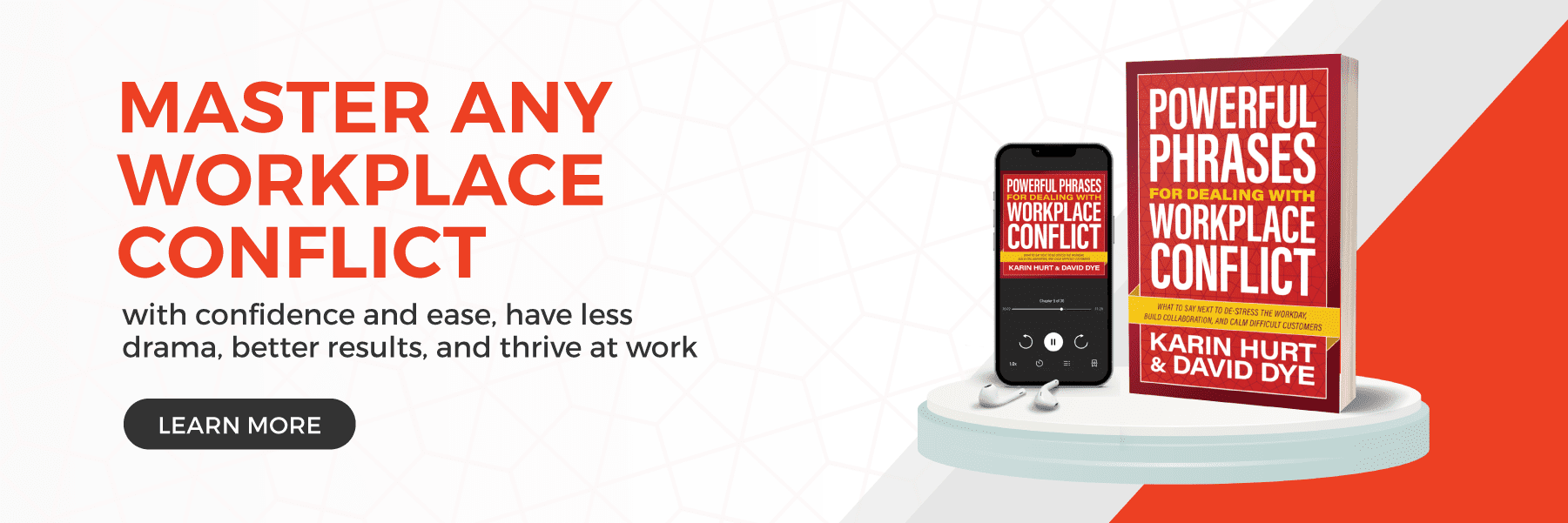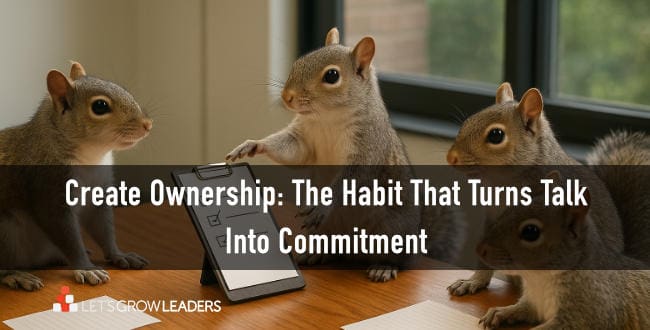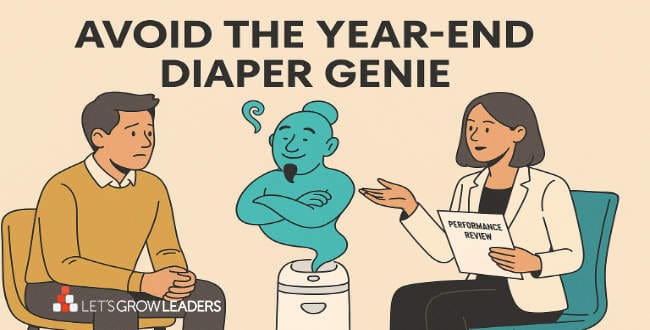“Agree to disagree” is dismissive, shuts down collaboration, and prevents meaningful solutions.
Faced with conflict at work, you might think “let’s agree to disagree” is an easy way to move on from the conversation. The words seem peaceful and hint at mutual respect. But in actual use, they aren’t peaceful, or helpful, at all.
The phrase implies a deadlock, which can prevent the resolution of underlying issues and hinder productive work relationships. Instead, you can use a few powerful phrases to create more collaborative conversations, solve problems, and build better relationships.
You won’t always agree, but there’s a better way to disagree.
Why “Agree to Disagree” is Trouble
Presumptuous Disrespect:
When you say, “let’s agree to disagree,” you are telling the other person what they will do – without their agreement, input, or consideration of their perspective. That’s presumptuous (assuming you know best) and dismissive, implying that further dialogue is pointless and that the other person’s viewpoint isn’t worth considering.
Avoidance of Resolution:
“Agree to disagree” often halts further discussion and doesn’t address the root causes of disagreement. Unresolved issues will surface again in ongoing tension and conflict.
Lack of Understanding:
Agreeing to disagree prevents you from fully understanding each other’s perspectives. This understanding is crucial for to build empathy, find common ground, and give you a chance at a solution.
Missed Opportunities for Innovation:
Collaborative disagreement is a source of creativity and innovation. Avoiding these discussions prevents teams from exploring diverse ideas that could lead to better solutions.
What to Say Instead of “Agree to Disagree”
When you have a serious disagreement with a coworker, rather than jumping straight to “agree to disagree,” you can use a few powerful phrases that open the door to better understanding, solutions, and improved relationships.
These G.O.A.T. (Greatest of All Time) phrases are rooted in the four dimensions of productive conflict: Connection, Clarity, Curiosity, and Commitment.
Connection—Do you know one another as human beings?
Every conflict is an opportunity to build a better relationship. Don’t lose the chance to connect by pushing someone away with “agree to disagree.” Here are some phrases you can use to “see” the other person and enhance connection:
“I care about [you/this team/this project], and I’m confident we can find a solution that works for all of us.” This phrase acknowledges the challenge while expressing confidence in a collaborative solution.
“Tell me more.” This is the complete opposite of “agree to disagree.” This simple but powerful phrase helps you learn more about the other person and helps them feel seen and heard.
“It sounds like you’re feeling [emotion], is that right? Thank you for letting me know how you feel.” This technique, known as “reflect to connect,” validates the other person’s feelings and builds rapport.

Clarity—Do you have a shared understanding of success?
So many workplace conflicts are misunderstandings. If you jump straight to “agree to disagree,” you lose the opportunity to create more clarity and truly solve problems. Here are a few phrases to help you build that shared understanding.
“What would a successful outcome do for you?” This question helps identify the desired end result, opening up possibilities for mutual understanding, collaboration, and solutions that can satisfy both of your needs.
“Can we start with what we agree on?” Finding common ground can reduce tension and create a cooperative atmosphere.
“What I’m hearing you say is [paraphrase]. Do I have that right?” This check for understanding ensures both parties are on the same page and can clear up any misinterpretations.
Another approach is “Here’s what I’m hearing you say so far. Please correct me where I’m wrong.” Then give your summary.

Curiosity—Are you genuinely interested in other perspectives and what’s possible?
The more you learn about other people’s perspectives, approaches, and experience, the easier time you’ll have collaborating and solving problems. But you won’t know if you don’t ask. Here are some curiosity phrases to use instead of “agree to disagree.”
“I’m curious how this looks from your perspective.” This straightforward phrase acknowledges that different perspectives exist. It’s so far from “agree to disagree” because it creates dialogue rather than shut it down.
“What do you suggest we do next?” Moving the conversation towards actionable steps helps you find solutions.
“What can I do to support you right now?” Offering support shows a willingness to help and can de-escalate tension.
Commitment—Do you have a clear agreement?
As you learn from one another, now you are in more of a position to move forward (rather than jumping straight to the presumptive “agree to disagree”). Focus on specific commitments to help move forward constructively:
“What’s one action we can both agree to as a next step?” This question narrows down the discussion to practical steps that can be taken immediately and looks for common ground.
“So, to recap our conversation, we’ve agreed to [summarize]. Is that your understanding?” Recapping ensures you both have a clear understanding of the agreements made, preventing future conflicts.
“Let’s schedule some time to talk about this again and see how our solution is working.” Scheduling a follow-up ensures continued commitment to resolving the issue and adjusting as necessary. Another anti-“agree to disagree” this phrase keeps the conversation going and keeps you engaged with one another.
Examples of Powerful Phrases in Action
Consider the following scenarios where these powerful phrases can replace “agree to disagree” and lead to more productive outcomes:
Scenario: Team Conflict Over Project Direction
Original: “Let’s just agree to disagree and move on.”
Alternative: “I care about our project’s success and I’m confident we can find a solution that works for all of us. What would a successful outcome do for you?”
Scenario: Disagreement on Work Processes
Original: “We’ll never see eye to eye on this, so let’s agree to disagree.”
Alternative: “It sounds like you’re feeling frustrated with our current process. Do I have that right? Let’s start with what we agree on and see how we can address the differences.”
Scenario: Conflict Between Team Members
Original: “We’ll just have to agree to disagree on this.”
Alternative: “I’ve noticed that we have different points of view on this issue and would love to learn more. How does this look from your perspective? What can we do next to move forward?”
But What About…
There might be a time where you can’t resolve differences or find a solution that meets everyone’s needs. (Less often than you might think, but it does happen.)
Especially in those moments, investing in connection, clarity, curiosity, and commitment is vital to build mutual respect and a collaborative relationship. Here are a few more phrases you can use in these times:
“So what you’re saying is… Do I have that right? That’s interesting. And I see it differently.” With this phrase, you create clarity with a check for understanding to ensure you have heard the other person. And you also affirm your own perspective—without telling them what they have to do or not do.
“I don’t expect either of us to change our mind about… Can we agree to…?” The key here is a constructive forward step—not “Can we agree to disagree”—that’s not constructive. For example, you might say, “Can we agree to respect one another and work together on this project in a way that serves our customers?”
Your Turn
There are so many ways to build your work relationships and find better solutions than telling someone, “Let’s agree to disagree.”
We’d love to hear from you: How does this look from your perspective? What is one of your most effective phrases when you face a serious disagreement at work?
(And if you want more powerful phrases to help with your most common workplace conflicts, check out Powerful Phrases for Dealing with Workplace Conflict):










0 Comments